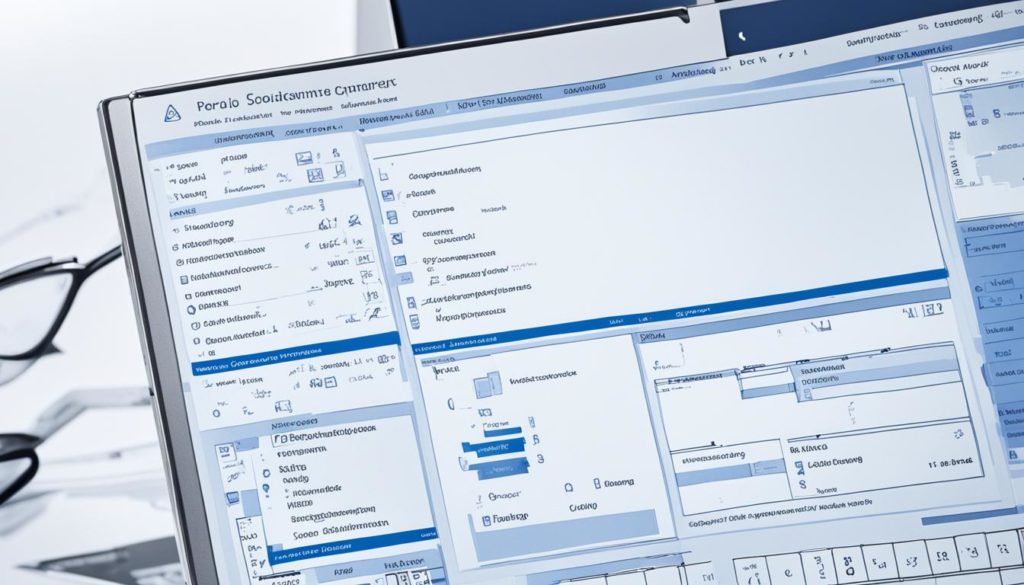
Let’s look at the case of, custom vs off-the-rack software. Custom software, tailor-made for your business, is gaining popularity. It’s expected to increase by 19.4% yearly from 2022 to 2030. This growth shows many companies are choosing custom solutions. Especially in areas like fintech, retail, IT, and manufacturing. But, the big question is, should you go for custom software that fits your business perfectly?
Or is it better to use off-the-shelf software, which is ready to use and cheaper? The choice between the two influences everything about how your business runs. It affects your efficiency, your competitive strength, and your potential for growth.
Custom software is designed specifically for your needs, creating a unique environment. This software can cater directly to your business’s growth and operations. Off-the-rack software has its perks, like being quick to start using and cheaper. But, it might not fit your business’s processes well. This could lead to problems later on, like slower work or inefficiencies.
For example, Walmart improved its supply chain with custom software. This allowed for faster order processing. Delta Air Lines uses specialized software for detailed flight planning and operations management. This shows how valuable custom software can be.
It’s important to really look at the differences between custom and off-the-rack software. This helps you understand how each can affect your business.
Key Takeaways
- The market for tailored solutions is exploding, with a predicted growth of 19.4% CAGR from 2022 to 2030.
- Fintech, retail, IT, and manufacturing are leading users of custom software.
- Custom software provides a personalized fit, whereas off-the-rack software offers quick deployment and lower costs.
- Notable entities like Walmart and Delta Air Lines leverage bespoke software for critical operational functions.
- Choosing the right type of software depends heavily on understanding your organization’s unique needs and growth trajectory.
Introduction to Software Choices
Choosing the right software is key for our business. There are two main types: custom software and off-the-rack software. Each type has its own unique benefits. These benefits affect how well the software fits our business.
Understanding Custom Software
Custom software is made just for us. It fits our needs perfectly. We get to decide how it works and looks. This level of control is great for our business.
But, making custom software is not cheap or quick. It can cost a lot of money and take a long time to finish. It might be years before it’s ready. Plus, if we want to add something later, that costs more, too.
Understanding Off-the-Rack Software
Off-the-rack software is ready-made for everyone. It’s like buying clothes from a store. This software is good for general needs and can be used right away.
One big plus is that it’s cheaper to start with. Also, there are teams to help us learn how to use it. They make sure we get off to a good start. Over time, the software gets better with updates. It’s safe and reliable, proven by others who use it too.
By knowing about custom vs off-the-rack software, people can choose what’s best. They can pick what meets their goals and fits their unique needs.
Key Differences Between Custom and Off-the-Rack Software
Choosing between custom and off-the-rack software means looking at key differences. Each type has its own benefits and drawbacks, especially concerning ownership, costs, and time to develop. Off-the-shelf software offers standard features, while custom software meets detailed business needs. Let’s explore these differences.
Definitions and Basic Concepts
Custom software, or bespoke software, is tailor-made for a specific organization’s needs. It fits business strategies closely and allows for future changes. Off-the-shelf software, on the other hand, is made for a wide range of users. It can be deployed quickly and costs less at first. This makes it a good option for those needing immediate use and reliability.
Ownership and Licensing
The ownership of custom software sets it apart. A company owns the custom software, giving them full control and rights. Off-the-shelf software is usually rented through licensing, which means the developer keeps ownership. Yet, with off-the-shelf software, users can get updates and support from the developer. This makes off-the-shelf software appealing in certain cases.
Development Time and Cost
Time and cost to develop software are critical. Custom software requires more money and time to build but provides cost savings later. It is made to fit exactly what a business needs. Off-the-shelf software, though cheaper initially, might need additional work. This can add costs. Understanding these aspects helps firms pick the right customization options.
| Aspect | Custom Software | Off-the-Shelf Software |
|---|---|---|
| Ownership | Owned by the commissioning company | Licensed user rights |
| Cost | Higher initial investment, potential long-term savings | Lower upfront costs, additional expenses for customization |
| Development Time | Longer, due to customization | Shorter, ready for immediate deployment |
| Flexibility | High, tailored to specific needs | Limited, may require customization |
| Support | Custom support solutions | Established support teams |
Benefits of Custom Software
Customizable software lets businesses shape their tools to fit perfectly. It aligns every operation closely, boosting efficiency and alignment.
Tailored Fit and Flexibility
Choosing bespoke software means getting an exact match for your needs. This custom solution is flexible, adapting easily to any changes your business faces. It’s not like ready-made software, which can’t evolve as your needs do.
It’s designed to keep up with your industry, meaning you’ll always be ready for what’s next.
Scalability and Integration
Custom software is great because it can grow with your business. It doesn’t need to be replaced when you expand. Plus, it smoothly merges with your current technology, making everything work well together.
This smooth operation gives you an edge over competitors, letting you do more.
Long-term Cost Savings
At first, custom software might seem more expensive. But, it saves money over time by cutting out the need for constant changes. It fits your processes exactly, which makes your business more efficient and lowers costs.
This strategy not only cuts expenses but also boosts your competitive position in the market.
Benefits of Off-the-Rack Software
Using off-the-rack software for business operations has big benefits. They include quick setup, are cheaper, and many people use them. They are known to work well because of large user bases that test the software.
Speed of Deployment
Off-the-shelf software is ready to use right away. This lets businesses start using it quickly. Custom software takes longer to make because it’s built just for one business.
Cost-Effectiveness
Typically, commercial software costs less than making software from scratch. This makes it a good choice for saving money. Small and medium businesses find this especially helpful.
Proven Reliability and Community Support
Many people use off-the-shelf software, so you know it works well. This is because it has been used in many different situations. Plus, you get help from a large user community for any issues you might face.
| Feature | Custom Software | Off-the-Shelf Software |
|---|---|---|
| Deployment Time | Long | Immediate |
| Upfront Costs | High | Low |
| Reliability | Varies | Proven |
| Community Support | Limited | Extensive |
Challenges of Custom Software
Custom software comes with lots of benefits but faces some big challenges too. One major obstacle is the high cost at the start. Because these solutions are made to meet a specific business’s unique needs, they can cost a lot to make. But, this money goes towards creating a perfect system for that organization.
High Upfront Costs
Creating custom software requires a big initial investment. This money covers not just building it, but also planning it out thoroughly. It’s important that the cost matches your budget and goals. Even though it’s a big cost at the beginning, the software being a perfect fit can make it worth it over time.
Development Time and Project Management
Unlike ready-made software, custom solutions take longer to get ready. They need time for the design, building, and testing phases. Good project management is key to watching over the process and making any needed changes. Using methods like Agile helps with staying organized and meeting deadlines.
Working with team members from different parts of the project can help efficiency. Sharing insights and progress helps avoid delays and keeps everyone on the same page.
Risk of Misalignment with Business Needs
Making software that fits exactly with what the business needs is tough. Sometimes, there are misunderstandings during the planning stage. This can lead to the software not meeting the goals right away, which may need expensive fixes. Using ATDD to test the software throughout can help catch issues early. This maintains the connection between what’s built and what the business actually needs.
Keeping everyone who’s interested in the software’s success in the loop is also important. This way, everyone can add their insights and keep the project heading in the right direction.
FAQ
What are the primary differences between custom and off-the-rack software?
Custom software is made for one business’s unique needs, giving them an exclusive tool. Off-the-rack software, on the other hand, is ready-made for many users with standard features. It can be used right away but may need changes to fit specific tasks.
How do ownership and licensing differ between custom and off-the-rack software?
Businesses own the custom software they pay for. For off-the-rack software, companies buy a license to use it but don’t own it outright.
How does the cost of custom software compare to off-the-rack software?
Custom software costs more upfront because it’s designed to fit exact needs. However, in the long run, it can save money by improving processes. Off-the-rack software is cheaper at first but might cost more later due to customization or fees.
Why would a business choose custom software over off-the-rack solutions?
Businesses choose custom software for its unique fit and flexibility to support particular tasks and strategies. It helps with scalability and can blend easily with other systems. This choice aims to save money in the long term and stand out from competitors.
What are the primary benefits of off-the-rack software?
Off-the-rack software is fast to get up and running, helping companies avoid delays. It’s usually cheaper at first and benefits from a large community that shares support and solutions.
What challenges are associated with developing custom software?
Creating custom software can be tough due to the high costs and long wait times. It also needs excellent project management. Plus, the final software might not meet all needs if there are misunderstandings during development.
Can off-the-rack software be customized to fit specific business needs?
Yes, some off-the-rack software can be adjusted to meet unique business needs. However, this kind of customization is usually limited compared to fully custom software.
Is custom software scalable?
Yes, one big advantage of custom software is how easily it can grow with a business. It’s designed to be expanded without needing a full rebuild, which helps maintain efficiency over the long term.
What kind of support is available for off-the-shelf software users?
Off-the-shelf software comes with support from the company that makes it. There’s also help from other users who share tips and advice, making the software more reliable.
How does the deployment time differ between custom and off-the-rack software?
Off-the-rack software is quick to get started. It fits general needs and comes ready to use. Custom software takes longer because it’s made for specific tasks, which means a longer wait before it’s fully ready.
Future App Studios is an award-winning software development & outsourcing company. Our team of experts is ready to craft the solution your company needs.










